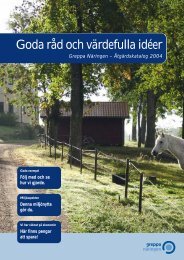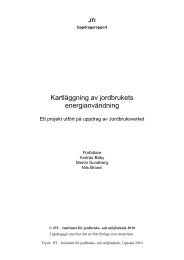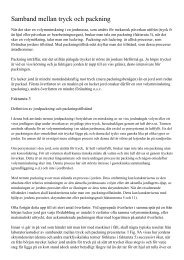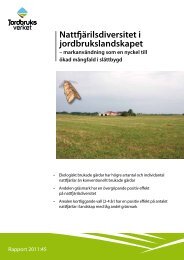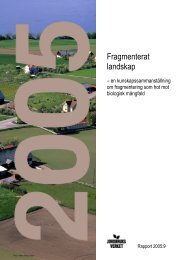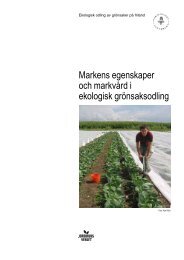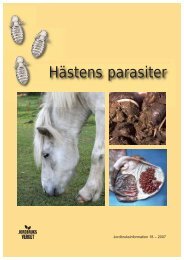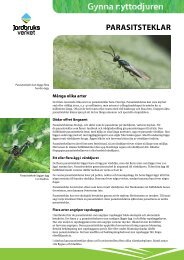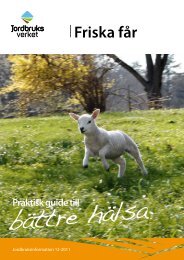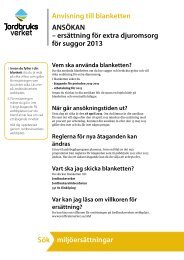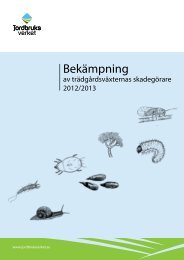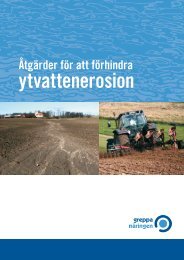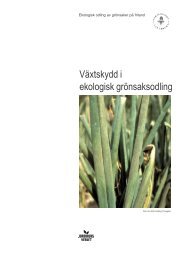Strategies for detection and delimitation surveys of ... - Jordbruksverket
Strategies for detection and delimitation surveys of ... - Jordbruksverket
Strategies for detection and delimitation surveys of ... - Jordbruksverket
You also want an ePaper? Increase the reach of your titles
YUMPU automatically turns print PDFs into web optimized ePapers that Google loves.
country. When the <strong>detection</strong> survey started in the Nordic countries this was a possibility<br />
that could not be ruled out. But now, after several years <strong>of</strong> sampling<br />
without positive findings in any <strong>of</strong> the Nordic countries, this possibility is highly<br />
unlikely. Thus, the main aim <strong>of</strong> the <strong>detection</strong> survey should now be an early <strong>detection</strong><br />
<strong>of</strong> new establishments to increase the possibility <strong>of</strong> eradication. It is obvious<br />
that the two first <strong>of</strong> the assumptions mentioned above are violated directly after an<br />
introduction <strong>of</strong> PWN. In such a situation PWN will only be present in a very<br />
restricted area <strong>and</strong> thus also the frequency <strong>of</strong> occurrence will be very low. Then<br />
over the years the area <strong>of</strong> distribution will increase <strong>and</strong> also the frequency <strong>of</strong><br />
occurrence. In a Nordic modeling project we have addressed this latter situation<br />
(Økl<strong>and</strong> et al. 2010). We used a simulation model approach to test one example<br />
<strong>of</strong> the draft contingency plans (the Norwegian, Mattilsynet 2007) <strong>for</strong> PWN eradication.<br />
This plan is similar to the suggested eradication measures <strong>for</strong> Sweden<br />
(<strong>Jordbruksverket</strong> 2008, Skog<strong>for</strong>sk 2010). The results <strong>of</strong> the simulations were used<br />
to evaluate the probability <strong>of</strong> eradication <strong>of</strong> the pest by the proposed measures<br />
should PWN be detected in Norway. Sensitivity analyses were used to analyse the<br />
influence <strong>of</strong> the biological parameter assumptions <strong>for</strong> the model results, <strong>and</strong> to<br />
analyse how changes in the parameters <strong>of</strong> the PWN survey <strong>and</strong> the draft contingency<br />
plan <strong>of</strong> Norway can increase the probability <strong>of</strong> successful eradication. In<br />
the model we assume that import <strong>of</strong> one PWN infestation (a PWN-infested beetle,<br />
e.g. M. galloprovincialis or M. alternatus) leads to PWN-infection <strong>of</strong> dead wood<br />
objects utilized by the local Monochamus populations which in turn start a spread<br />
<strong>of</strong> PWN to an increasing proportion <strong>of</strong> the existing native Monochamus population<br />
<strong>and</strong> its breeding objects. The model keeps track <strong>of</strong> PWN-infested objects <strong>of</strong><br />
Scots pine <strong>and</strong> Norway spruce.<br />
In Norway an average number <strong>of</strong> 420 samples have been collected per year from<br />
an area <strong>of</strong> 78540 km 2 (10 circles <strong>of</strong> 50 km radius defined as risk areas) (Magnusson<br />
et al. 2007). Based on estimates <strong>of</strong> number <strong>of</strong> dead wood objects per km 2<br />
these 420 samples represent 0.02 % <strong>of</strong> the available dead wood objects estimated<br />
to be colonized by Monochamus beetles. These figures are <strong>of</strong> the same magnitude<br />
as <strong>for</strong> Sweden: the total area <strong>of</strong> <strong>for</strong>est l<strong>and</strong> in Sweden is about 220 000 km 2 <strong>and</strong><br />
the average number <strong>of</strong> samples per year is <strong>of</strong> the same magnitude as in Norway. In<br />
the model simulations we assume one entry <strong>of</strong> PWN somewhere within the Norwegian<br />
survey area <strong>and</strong> the model was then run <strong>for</strong> 20 years to record the final<br />
eradication success when applying the Norwegian contingency plan (Mattilsynet<br />
2007). With the present Norwegian <strong>detection</strong> survey the probability <strong>of</strong> <strong>detection</strong> in<br />
the first year was very low (0.013 %) <strong>and</strong> the average number <strong>of</strong> years until <strong>detection</strong><br />
was 14. This is not surprising considering the low proportion <strong>of</strong> Monochamus-colonized<br />
dead wood objects sampled (0.02 %). Even if the number <strong>of</strong><br />
samples was strongly increased to 60 000 per year the probability <strong>of</strong> <strong>detection</strong><br />
only increased to 17 %. As the number <strong>of</strong> infested dead wood objects built up<br />
exponentially, the first <strong>detection</strong> in many cases consisted <strong>of</strong> several infested<br />
objects.<br />
The model-estimated probability <strong>of</strong> <strong>detection</strong> is conservative in several ways. It<br />
does not take into account that establishment could occur outside the survey areas,<br />
that PWN in some cases may not be detected in samples from infested wood<br />
objects <strong>and</strong> that human-mediated dispersal <strong>of</strong> PWN-infested wood could increase<br />
the rate <strong>of</strong> spread (Robinet et al. 2009).<br />
15



